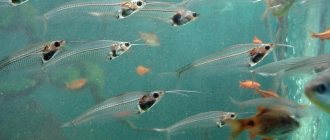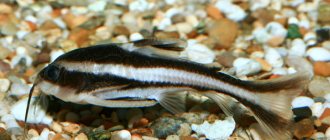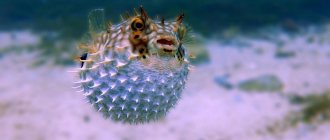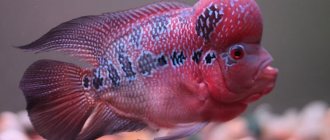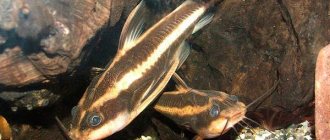Scorpena
I wouldn’t say that these fish look funny, but rather unusual. Which, in fact, attracts the attention of both oceanographers and simply lovers of marine fauna. The name of these “monsters” is no coincidence, since by their nature they are poisonous, not only to aquatic inhabitants, but also to humans. And what is most surprising is that scorpionfish are capable of molting, and some species change their skin with enviable regularity - once every one to two months.
The eccentric appearance of the fish is given by chaotic growths covering the entire body. They can be in the form of tufted moss, branched horns, or roots resembling coral or algae. The bright coloring also adds originality, creating real watercolor paintings on the body. Thanks to this surroundings, the predator can perfectly camouflage itself in coral thickets, patiently waiting for its prey.
Scorpio fish cannot be called good swimmers; they cannot handle long distances, although they can be active if necessary. They are recognized loners, so they do not flock together, preferring to rely only on their own strength. Like partisans, they lie in ambush, disappearing into the surrounding landscape and guarding their prey for hours.
Moreover, these underwater “scorpions” are excellent at the art of camouflage, so they can also skillfully burrow into the ground, arranging a convenient observation post for themselves. As soon as a potential victim appears on the horizon, the fish opens its mouth, without even bothering with unnecessary body movements, and “allows” the current to carry the poor fish or shrimp directly into its mouth. Most often, hunting occurs at night.
The presence of a sensitive zone with special receptors located on the side of the body allows you to read water fluctuations and accurately determine the location of prey. These unusual predators are found in tropical and subtropical seas, mainly Thailand, the Philippines, and Malaysia.
Psychedelic frog fish
The strange name of this fish was not given by chance. She really looks like an alien from outer space, or at least like a fan of The Prodigy. This “beauty” was discovered relatively recently, in 2009, and since then it has consistently taken top places in ratings of the most amazing marine inhabitants of the planet.
Unlike other fish, the psychedelic frog has no scales, and it also cannot boast of strong muscles. The skin, flabby and thick like an old woman, hangs down on the sides, trembling from vibrations in the water. Due to the fact that the fish prefers to hide in coral reefs, which are prickly and can hurt, its body is often covered with viscous mucus as protection.
Another interesting fact is the uniqueness of the color. Like human fingerprints, all “psychedelics” have their own individual body pattern. It is usually a mottled pattern of wavy stripes of white, yellow and brown. Even the eyes don’t look like fish—small, keen-sighted, like beads on a colorful carpet.
The bright color allows it to camouflage perfectly among the thickets of corals, literally disappearing into the branchy bushes. Even experienced divers are unable to immediately determine that in front of them is a living organism, and not just a multi-colored twig. The unusual structure of the pectoral fins allows them not only to swim, but also to crawl along the bottom, and even jump, pushing off stones and other hard surfaces. This ex is found in the Indian Ocean, mainly near the island of Bali.
Witch
Witchfish, slug eel, is an unpleasant creature of the hagfish family Cyclostomata. Not all scientists agree that the slug eel is a fish, but many (by analogy with lampreys) classify the hagfish as a member of this group of aquatic vertebrates.
The hagfish is very slippery and impossible to hold, and this is its primary defense mechanism. When the danger has passed, she sheds mucus.
The eyes are hidden under the skin. It has a length of up to 40-45 cm. Giant specimens up to 80 cm in size are very rare. This nocturnal fish is a predator. Preys mainly on weak and sick fish; they are easy to catch and smother with mucus. None of these creatures are on the list of the most dangerous fish, but they can cause harm to humans and other marine life.
Rag picker
When you see this touching creature, only one thing comes to mind - how funny and beautiful it is at the same time. The name of the seahorse that lives in the coastal waters of Australia was chosen well. Its resemblance to a rag torn into small pieces is very clearly visible. The second “nickname” of the fish also brings a smile - grass sea dragon.
Despite its small size and slender build, the rag picker belongs to the category of predators, feeding on small shrimp and fish. He swallows them whole due to the lack of teeth. The grass dragon's ability to mimic has been brought to perfection. Among the swaying kelp bushes and sargassum algae, it becomes invisible, which helps it hide from larger predators. Due to its physique and inability to swim quickly, the seahorse always chooses the chameleon strategy - it is better to pretend to be a plant than to run away.
Family “traditions” are also unusual. The male attracts the female with skillful mating dances, and then, when she lays eggs, he transfers all the burdens of childbearing to his back. Or rather, the tail, where the newly-made wife glues his eggs. You can also meet the fish off the coast of Tasmania. Usually it does not go deeper than 20 m, as it loves warm water and good lighting. She even had the honor of becoming the “face” of the state of Victoria and came under the protection of the Australian government.
Blob fish
It can safely be awarded the title of the saddest fish on earth. However, for all her sadness, she looks very funny. Either a gnome, or a brownie, or an alien with a shapeless head and a large potato nose - it is difficult to describe the appearance of the fish in two words. There are no scales or fins on the body of this strange creature, and there is also no spine as such. Essentially, it is a gelatinous mass without muscles that floats like a shapeless bag.
The drop fish lives at a depth of approximately 800-1200 m, so it is still little studied. You can meet it in the waters near New Zealand and Australia.
It feeds on small invertebrates and various plankton, without particularly straining to find food. She simply “hangs” in the water, waiting for something edible to fall into her mouth. The drop does not float to the surface - it is not interested in it. But fishermen are not against getting such an unusual trophy into their nets and selling it at a higher price on the black market.
Surprisingly, these sad, big-nosed “melancholic people” turn out to be very caring parents. They selflessly take care of their offspring, surrounding them with warmth and attention until the time when the fry grow up. Scientists have not yet determined exactly how a male finds a female and how the process of “marriage” goes. It is only known that the fish lays eggs in the ocean soil, and then lies down on it and conscientiously hatches it.
Fish - old wife
At first glance, you won’t see anything strange in this bright striped fish. Such a nimble fidget, driving at high speeds between coral thickets. She received her nickname not for any special appearance, but for her ability to grind her teeth and make grumbling sounds when worried or in danger. It’s difficult to say who exactly gave it this name, seeing the similarity of the “vocal apparatus” of fish and boring women, but the fact remains that it sounds funny.
The old wife fish is found in the waters of the Indian and Pacific Oceans, preferring to swim near the coast of Australia. On the back of the grunt there are two fins with poisonous spines. Despite its aggressiveness and “talkativeness,” the fish is a fairly frequent visitor to marine aquariums. She is incredibly voracious and unpretentious to food, swallowing everything that is given to her - chopped squid, shrimp, plankton, mussels and other seafood. She does not disdain dry food, digesting any “semi-finished products” without any problems.
Once in artificial conditions, it gets along quite well with other marine life. Depending on the mood, the fish-old wife can remain either in splendid isolation or in flocks. Schools of striped “butterflies” are very interesting to watch, especially when their games take place to a funny sound accompaniment.
Funny and unusual fish names
The world's oceans are inhabited by a huge variety of fish. Some of them have unusual and even funny names. But if you take a close look, it will become clear where these names came from and that this is not the figment of someone’s crazy imagination, but a completely logical explanation for the appearance or character of the fish. Often a fish in body shape, color or behavior resembles another animal, some object or even a person of a certain profession. Hence the names. Let's look at the most interesting specimens.
The hedgehog fish, for example, inflates its body to a spherical shape, completely studded with sharp bone needles; it becomes surprisingly similar to an ordinary hedgehog.
Red mullet. Why the red mullet is called red mullet is unknown. But it is known that this fish has tasty and tender meat. It was especially valued in ancient Rome. If you believe the legends, large red mullets were paid with an amount of silver equal to their weight.
The boar fish in profile resembles a wild boar, the front part of the seahorse's body repeats the configuration of the head and neck of a horse, and the fish itself is an almost exact copy of one of the chess pieces.
Angelfish are a real gem of a marine aquarium. Their coloring is impressive: all shades of the rainbow spectrum and intricate patterns of longitudinal and transverse, oblique and rounded lines.
The head of the rabbit fish looks like a rabbit's muzzle; moreover, it has a small mouth and teeth in the form of incisors. There is also a catfish in Australia.
Among the inhabitants of the deep waters there are also “celebrities”, for example, the Napoleon fish. It is distinguished by a characteristic growth on its head, which resembles Napoleon's cocked hat. Such a fish is curious and approaches divers without fear; you can even stroke it, but on neutral territory. If you “ask” to visit her, she may bite. Nature has awarded the Napoleon fish with strong teeth, which it can use to crack the shells of crabs and shellfish, so we do not recommend taking risks.
In the parrot fish, the teeth on each jaw have fused together and become similar to the beak of a parrot. At the same time, this fish also has a very bright color.
Another “celebrity” is the Picasso fish. When you see its coloring, you don’t even have any questions about why it’s called that – it’s very reminiscent of the avant-garde-style works of the great painter.
The frog-fish is characterized by a short, swollen body at the front, covered with thick skin without scales. And the toad fish is famous for the fact that with the help of its swim bladder it makes unusually loud sounds, which in calm weather can be heard on the seashore.
The wart or stone fish is considered the most poisonous fish in the world. The body of the stonefish is covered with bumps and warts, and the dorsal fin has hard, poisonous spines. Externally, the fish looks like a stone, it is very difficult to notice. Such a fish is very dangerous for humans: if he steps on it or touches it, the wart will stick its fin spines, which contain poison, into him.
In the razor fish, the body is laterally compressed and covered with thin bony plates, forming something like a sharp knife on the lower edge of the belly. The long and very thin needlefish is similar to a sewing needle. The sawfish's snout resembles an elongated blade, along the edges of which there are teeth. The head of the hammerhead fish has two large outgrowths on the sides, giving it the appearance of a sledgehammer; the swordfish has an unusually elongated and pointed upper jaw.
Sea grunts. These fish are so named due to their ability to produce loud “grunting” sounds due to the contraction of the swim bladder, which is compressed by the muscles surrounding it. Large grunts are of great commercial importance, and small ones are quite popular among aquarists.
One of the most romantic names for fish is the moon fish. Due to its unusually short and laterally compressed body, this fish really resembles the disk of the moon.
Surgeon fish swim in the depths of the sea, so named for the sharp spines located at the top and bottom of the caudal fin. Because of such a sharp tail, the fish are sometimes called “scalpel fish.” Pisces use it as a weapon of self-defense.
One of the fish that lives off the Pacific coast of America has long been called candlefish. The long body of this fish contains a lot of fat. Dried fish equipped with a wick burns for a long time with an even flame that does not flare up.
“Evil spirits” are also found in the depths of the sea. For example, witch fish and dracula fish.
The witchfish lives in the depths, feeding on small living fish, dead and dying. It is considered a nocturnal animal. This monster is also the slimiest creature on the planet. In addition, the witch fish is the only one of all fish that can sneeze.
Dracula fish is the name scientists gave to fish discovered in 2007 in small bodies of water in Myanmar. They got their terrifying name from 2 huge fangs located on the upper jaw.
The midshipman fish has luminous spots on its body, reminiscent of carefully polished metal buttons on a sailor's jacket. There is also a captain fish and a knight fish. Its body is covered with a solid shell, consisting of very strong large scales, each of which has a ridge with a spike.
There are many unusual fish with unusual names found in Australia. Scuba divers sometimes meet there, for example, an old wife fish. In ichthyological dictionaries there are also such names: marinka, eudoshka, anglerfish, surgeon and grumbler. Imagine your reaction if in a fish store they offer you “Marinka in a spicy sauce,” “Spicy-cured surgeon,” or “Grumpy in its own juice.”
In the Seychelles you can see the mademoiselle shark and the nose shark.
Studying the names of fish and their varieties, you understand that nature’s imagination is limitless. We have only talked about some interesting sea creatures, but in fact there are many of them.
Egg cutter fish
A tropical fish from the piranha family, whose main habitat is the waters of the Amazon. It feeds mainly on small fish, plant seeds, acorns and nuts. Externally, the fish does not stand out in anything special, except for its large size - the length of an adult individual can reach up to 90 cm and weight up to 10 kg. Then why does it have such a strange name? The thing is that the egg cutter often encroaches on the manhood of local fishermen who do not bother to wear underwear. Not seeing the difference between forest and human “nuts”, she happily bites off her favorite delicacy.
Eating mainly plant foods, fish can switch to animal food without any problems. Unlike its distant relatives, predatory piranhas, the egg cutter does not have sharp teeth; on the contrary, the dentition is smooth with a clearly defined arch, and the structure itself resembles a human mouth. Hunters of male testicles, among other things, are also long-lived. In the natural environment they can live up to 30 years, but in aquarium conditions they can withstand 10 years.
The saddest thing is that when having such a fish at home, most amateur aquarists do not think at all about the peculiarities of its maintenance. Having a good appetite, it literally grows before our eyes in a matter of months and physically no longer fits in the aquarium. And then the unlucky owners are forced to release the fish into the wild, lowering it into the nearest open body of water. It is not difficult to guess what fate awaits men who are not lucky enough to find themselves on the path of the egg cutter at this time. Over the past few years, a number of precedent cases have already occurred in Denmark, Switzerland, Scotland and the USA.
Egg cutter
This is a large freshwater fish of the piranha family, living in the tropical latitudes of the Amazon River. Its other name is red-breasted pacu. The teeth are rectangular and look like human teeth. The pacu feeds on small fish, snails, and nuts.
The egg cutter got its funny name from local male residents who are often in the water without clothes. Paku confuses their manhood with nuts that have fallen into the water and tries to take a bite.
Toothpick fish
A small nimble fish from the wrasse family one hundred percent lives up to its name. Not only people need oral care, but also the inhabitants of the seabed. This is exactly what the nimble toothpick does - it cleans parasites from the teeth of large fish, and then feeds on them. At the sight of the “orderly”, moray eels, snappers, horse mackerel and other giants open their mouths, move their fins and freeze, waiting to be rid of the accumulated garbage.
Moreover, the fish even independently find a small toothpick, patiently lining up to perform “sanitization”. It doesn’t matter whether it is a predator or not, during the procedure all instincts freeze, and no attacks are made on the nimble worker. When the “clients” decide that the work needs to be completed, they close their mouths for a few seconds and then open them again. This serves as a sign to the toothpick fish that it is time for it to leave.
Some fish even change colors during the cleaning period to make it easier for the fish to see the parasites. But sharks have to be adapted and serviced on the move due to their inability to freeze in place. To make the toothpick easy to spot among the corals, nature has endowed it with a bright striped color. According to this guideline, “clients” who need “cleaning services” find her. The average size of the fish is approximately 10-20 cm, and it is found in the warm waters of the Red Sea and the Indian Ocean.
Box
Another well-known name for the fish is the cube box. Heat-loving, almost square-shaped individual from the Pacific, Atlantic and Indian oceans, inhabitant of coral reefs. Juveniles are yellow with blue polka dots; as they mature, the color changes to green with blue and yellowish spots.
Reaches 0.5 m in length, is poisonous - it secretes mucus with a potent toxin.
They are kept in large aquariums, but carefully monitor the condition - when frightened or in danger, the aquatic animal begins to secrete poison that can destroy all its neighbors.
Box fish
Visually, this tropical fish really resembles a floating colored box. It is easily recognized by its unusual cubic shape and bright yellow color with black speckles. These funny creatures live in coral lagoons, showing talents of camouflage. The entire body of the box fish consists of a so-called bony shell, in which gaps are left only for the mouth and eyes.
Despite their apparent bulkiness, these eccentrics are quite nimble, but very timid. They prefer to swim in splendid isolation, rarely gathering in groups and, especially, in flocks. They are absolutely unpretentious in food, not disdaining plankton, small mollusks, or bottom worms. Favorite delicacy is seaweed. The ability to produce toxic mucus helps them protect themselves from predators. That is why it is not recommended to keep them in an aquarium together with other fish.

